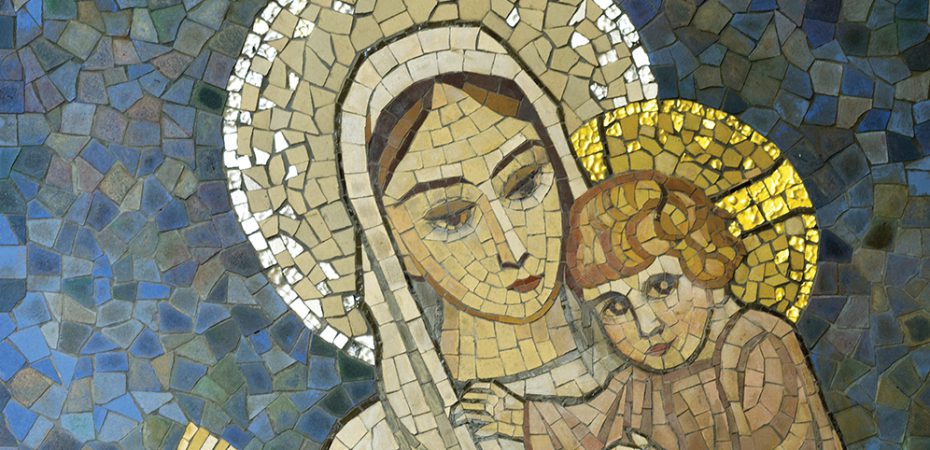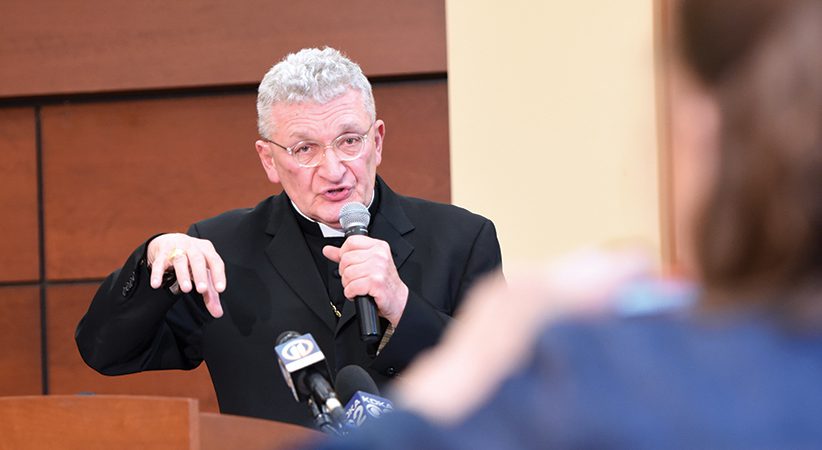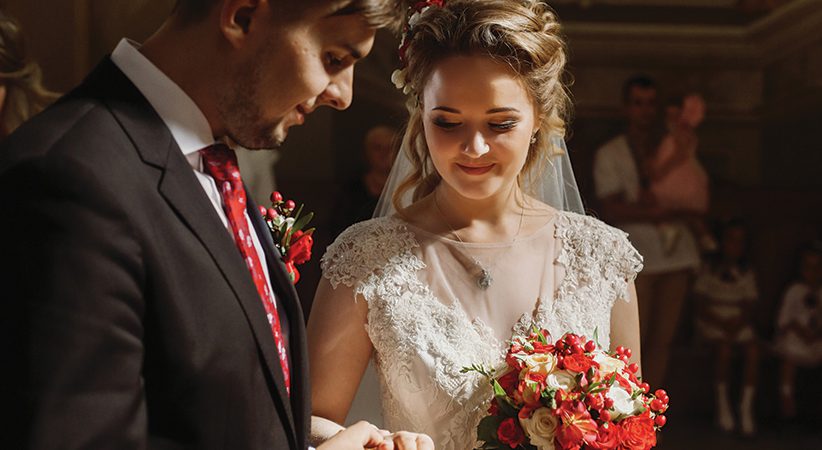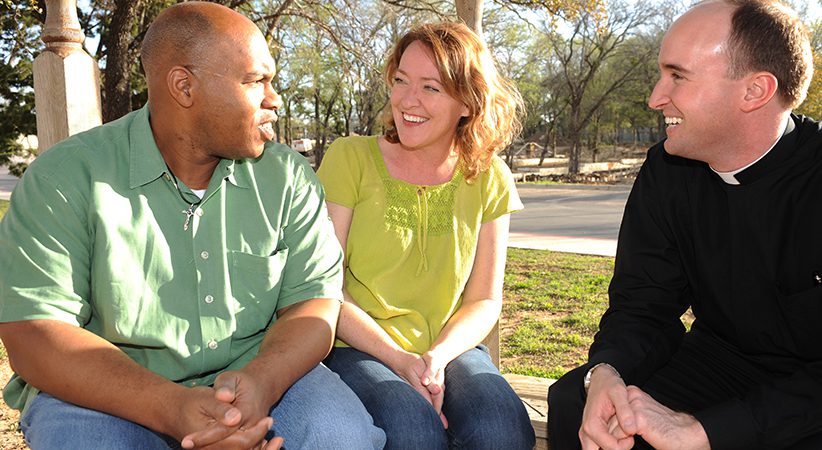Mary, Mother of Priests
How Our Lady can help form priests in the image of her divine Son
Dr. Robert Fastiggi Comments Off on Mary, Mother of Priests
On January 1, the Church celebrates the solemnity of Mary, Mother of the God. Although Mary is the mother of all the members of Christ’s Mystical Body, she is the mother of priests in a special way. Our Lord told the beloved disciple John to behold the Virgin Mary as his mother under the cross (cf. Jn 19:27).
Although the beloved disciple represents all the faithful, he represents priests in a particular way. In his 1950 apostolic exhortation, Menti Nostrae, which focused on the development of holiness in the priestly life, Pope Pius XII states, “Our Lady loves everyone with a most tender love, but she has a particular predilection for priests who are the living image of Jesus Christ” (No. 142). Later, in the same document, the pope refers to Mary as the “Mother of Priests,” and he reminds his brother priests, “When you meet very serious difficulties in the path of holiness and the exercise of your ministry, turn your eyes and your mind trustfully to her who is the Mother of the Eternal Priest and therefore the loving Mother of all Catholic priests” (No. 141). Pius XII also speaks of priests as “sons of the Virgin Mary,” and he calls upon all priests “to love her with an ardent piety, invoke her with perfect confidence, and frequently implore her strong protection” (No. 49).
Special Relationship
Mary’s special relationship with priests is manifested by her presence with the apostles in prayer awaiting the outpouring of the Holy Spirit at Pentecost (cf. Acts 1:14). This is why she is honored with the title Queen of Apostles in the Litany of Loreto. Although Mary is queen, she is most of all mother to priests, who are configured to the person of her divine Son in a most intimate way. In his 1935 encyclical, Ad Catholici Sacerdotii, Pope Pius XI states, “The priest even more than the faithful should have devotion to Our Lady, for the relation of the priest to Christ is more deeply and truly like that which Mary bears to her Divine Son” (No. 39).
Although the maternal relationship of the Virgin Mary to priests has been present since the beginning of the Church, it was during the Middle Ages that religious congregations of priests devoted to the Blessed Virgin Mary became more numerous. The Order of the Servants of Mary (the Servites), for example, was founded outside Florence, Italy, in 1233 by seven Florentine nobles with a special devotion and commitment to Our Lady of Sorrows.
………………………………………………………………………………………………………………………………………………………………
Further Reading
Robert L. Fastiggi and Michael O’Neill, authors of “Virgin Mother Queen: Encountering Mary in Time and Tradition” (Ave Maria, $17.95), provide a resource for those who desire to learn more of the multitude of titles and attributes that stem from approved Marian apparitions throughout the world.
………………………………………………………………………………………………………………………………………………………………
In the post-Tridentine period, the relationship between the priest and Mary was manifested by Cardinal Pierre de Bérulle (1575-1629), the founder of the Parisian Oratory, who asked his priests to take a vow of servitude to Jesus and Mary. Cardinal Bérulle’s disciples, Charles de Condren (1588-1641) and Jean-Jacques Olier (1608-57) — the founder of the Sulpicians — encouraged priests to recite a prayer that begins, “O Jesus, living in Mary, come and live in me, in your spirit of holiness, in the fullness of your virtue, in the perfection of your ways.”
In the 17th through 19th centuries, other religious communities were founded that emphasized the special maternal relationship of Mary to priests. Mention can be made of the Congregation of Jesus and Mary (the Eudists), founded in 1643 by St. John Eudes; the Missionaries of the Company of Mary, founded in 1705 by St. Louis de Montfort; the Missionary Oblates of Mary Immaculate, founded in 1816 by St. Eugène de Mazenod; and the Society of Mary, founded in 1817 by Blessed William Joseph Chaminade.
Since the 17th century, many spiritual writers have underscored the filial relationship between priests and the Blessed Virgin Mary. John Eudes (1601-80) not only considered Mary the mother of priests, but he also believed that priests could enter into a type of mystical espousal with the Blessed Virgin Mary in order to consecrate their bodies, hearts and souls entirely to her care. The maternal relationship, however, predominated over the spousal one. This is because Mary is the Mother of Christ, the eternal high priest, and the priest serves as an alter Christus, another Christ.
A book that synthesizes the key insights of Mary as mother of priests is “Mary and the Priestly Ministry” by Marianist Father Emile Neubert (1878-1967) — published by the Academy of the Immaculate in 2009. In this book, Father Neubert notes that the special role of the priest is to extend the priesthood of Christ, and “Mary then carried all her Son’s future priests in her womb along with him” (pp. 11–12).
Father Neubert points out that there are similarities and parallels between the priest and Mary. The Blessed Virgin “gave substantial existence to Christ-priest when she gave him a physical body” (p. 35). The priest, in turn, makes present Christ’s body in the Eucharist. Mary offers up the divine Victim to “to accede to the will of God and obtain grace for humankind,” and the priest “offers up the same Victim for special purposes and on behalf of particular individuals” (p. 36). Mary’s participation in the mysteries of the Incarnation and redemption makes her the spiritual mother of souls. The priest exercises a spiritual paternity with regard to souls, and “he acts in the name of two mothers — Mary and the Church” (p. 37).
……………………………………………………………………………………………………………………………………………………..
Five Reasons Mary Loves Priests
In the book “Mary and the Priestly Ministry” (Academy of the Immaculate, $5), Marianist Father Emile Neubert notes that Mary loves all of the faithful “with an incomparable love,” but she loves priests “with an altogether unique love” for five main reasons:
1) Because Mary sees that a priest has a greater resemblance to her divine Son.
2) Because Jesus loves his priests with a distinctive love and Mary shares all the feelings of her Son.
3) Because priests give “worldwide efficacy to the mission of her Son” and they make the blood he shed “efficacious in souls.”
4) Because Mary, under the cross, prayed and offered her sufferings in union with Christ, priest and victim, and she ceaselessly prays for the sanctification and success of priests who make present her Son in the sacrifice of the Mass.
5) Because Mary needs priests so that she can carry out her mission of giving Christ to the world.
……………………………………………………………………………………………………………………………………………………..
Father Neubert goes on to explain why priests have a special need for Mary as their mother. Priests need the help of the Blessed Mother to obtain graces for them. They need her help in forming into good priests, in the image of her divine Son. Mary also serves as a motherly teacher of priests. She teaches them how to live by faith and grow in poverty, chastity, obedience, humility and charity. Mary also gives confidence to priests, especially when they consecrate themselves to her in a special way. Mary wills the success of priests because this success gives glory to God, promotes the mission of her Son, and benefits all of her spiritual children who grow in grace through the sacraments provided by priests.
The insights of Father Neubert on Mary as mother of priests harmonize with the teachings of recent popes and the magisterium. Pope Pius XII, in his 1954 encyclical Sacra Virginitas, calls upon priests to entrust themselves to the maternal care of Mary in order to grow in chastity:
“The eminent way to protect and nourish an unsullied and perfect chastity, as proven by experience time and again throughout the course of centuries, is solid and fervent devotion to the Virgin Mother of God. … Therefore in a paternal way we exhort all priests, religious men and women, to entrust themselves to the special protection of the holy Mother of God who is the Virgin of virgins and the ‘teacher of virginity,’ as Ambrose says, and the most powerful Mother of those in particular who have vowed and consecrated themselves to the service of God” (No. 64).
Second Vatican Council
The Second Vatican Council also recognizes Mary as mother of priests and those in priestly formation. Presbyterorum Ordinis, the Decree on the Ministry and Life of Priests, exhorts priests to “love and venerate with filial devotion and veneration this mother of the Eternal High Priest, Queen of Apostles and Protector of their own ministry” (No. 18). The council’s Decree on Priestly Formation, Optatam Totius, says that seminarians “should love and venerate with a filial trust the most blessed Virgin Mary, who was given as mother to the disciple by Christ Jesus as He was dying on the cross” (No. 8). The importance of Mary in seminarian training is likewise found in the 1983 Code of Canon Law, which states that “the veneration of the Blessed Virgin Mary, including the Marian rosary, mental prayer, and other exercises of piety are to be fostered; through these, students are to acquire a spirit of prayer and gain strength in their vocation” (Canon 246.3).
During his pontificate St. John Paul II (1978-2005) often reminded priests to see the Blessed Virgin Mary as their Mother. This is seen in his first Holy Thursday Letter to Priests of April 8, 1979, when he wrote:
“Dear Brothers, at the beginning of my ministry I entrust all of you to the Mother of Christ, who in a special way is our Mother: the Mother of Priests. In fact, the beloved disciple, who, as one of the Twelve, had heard in the Upper Room the words ‘Do this in memory of me’ (Lk 22:19), was given by Christ on the Cross to his Mother, with the words: ‘Behold your son’ (Jn 19:26). The man who on Holy Thursday received the power to celebrate the Eucharist was, by these words of the dying Redeemer, given to his Mother as her ‘son.’ All of us, therefore, who receive the same power through priestly Ordination have in a certain sense a prior right to see her as our Mother. And so I desire that all of you, together with me, should find in Mary the Mother of the priesthood which we have received from Christ. I also desire that you should entrust your priesthood to her in a special way” (No. 11).
Pope Francis has also recognized Mary as the teacher and mother of priests. In his Dec. 5, 2014, address to the International Theological Commission, he referred to the Madonna as “the teacher of authentic theology.” On Aug. 4, 2019, he issued a letter to priests on the 160th anniversary of the death of the Curé of Ars, St. John Vianney. In this letter, the pope shares his own trust in Mary as his mother:
“Whenever I visit a Marian shrine, I like to spend time looking at the Blessed Mother and letting her look at me. I pray for a childlike trust, the trust of the poor and simple who know that their mother is there, and that they have a place in her heart. And in looking at her, to hear once more, like the Indian Juan Diego: ‘My youngest son, what is the matter? Do not let it disturb your heart. Am I not here, I who have the honor to be your mother?’”
All priests should learn from Mary as their teacher and turn to her with childlike trust because she is their mother. Mary is the Mother of the Church and the mother of all people. In a special way, though, she is the mother of priests because she sees in them the reflection of her beloved Son, Jesus Christ — the High Priest and Savior.
ROBERT FASTIGGI, Ph.D., is a professor of systematic theology at Sacred Heart Major Seminary in Detroit. He is former president of the Mariological Society of America.
………………………………………………………………………………………………………………………………………………………
Commemorating Mary, Mother of God
“In the revised ordering of the Christmas period it seems to us that the attention of all should be directed towards the restored Solemnity of Mary the holy Mother of God. This celebration, placed on January 1 in conformity with the ancient indication of the liturgy of the City of Rome, is meant to commemorate the part played by Mary in this mystery of salvation. It is meant also to exalt the singular dignity which this mystery brings to the ‘holy Mother … through whom we were found worthy to receive the Author of life.’ It is likewise a fitting occasion for renewing adoration of the newborn Prince of Peace, for listening once more to the glad tidings of the angels (cf. Lk. 2:14), and for imploring from God, through the Queen of Peace, the supreme gift of peace. It is for this reason that, in the happy concurrence of the Octave of Christmas and the first day of the year, we have instituted the World Day of Peace, an occasion that is gaining increasing support and already bringing forth fruits of peace in the hearts of many” (Marialis Cultis, No. 5).
………………………………………………………………………………………………………………………………………………………..





